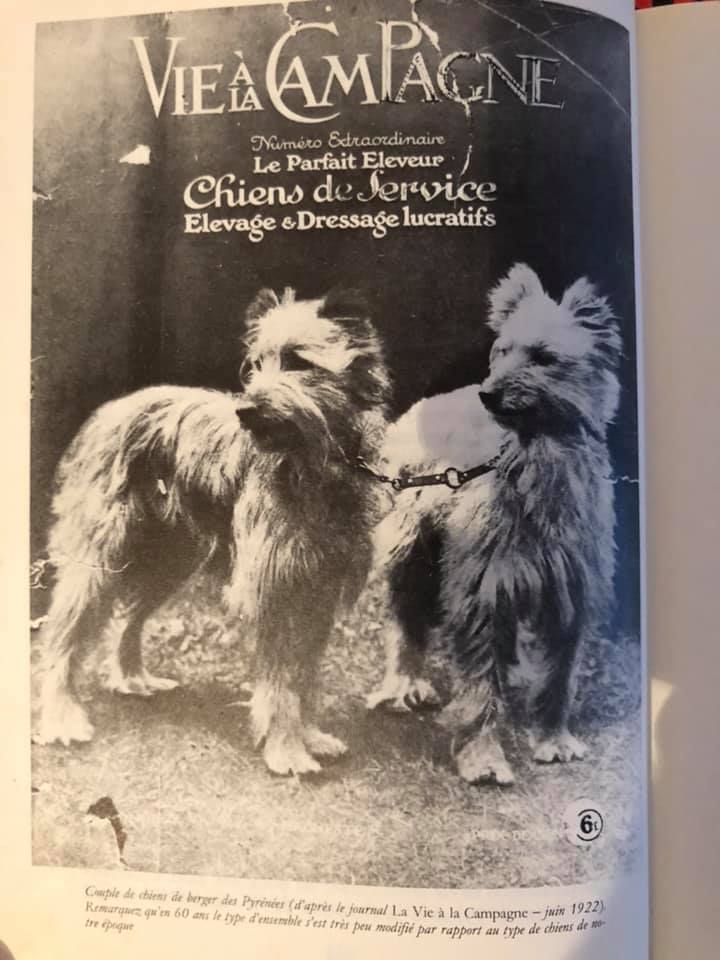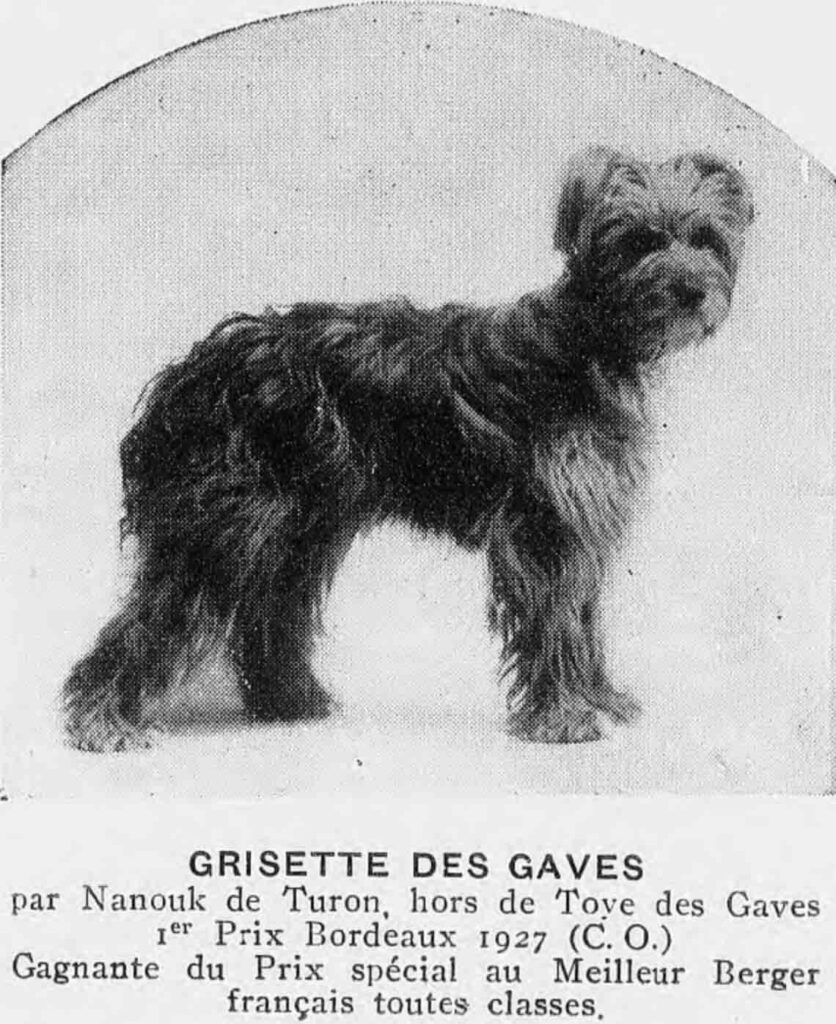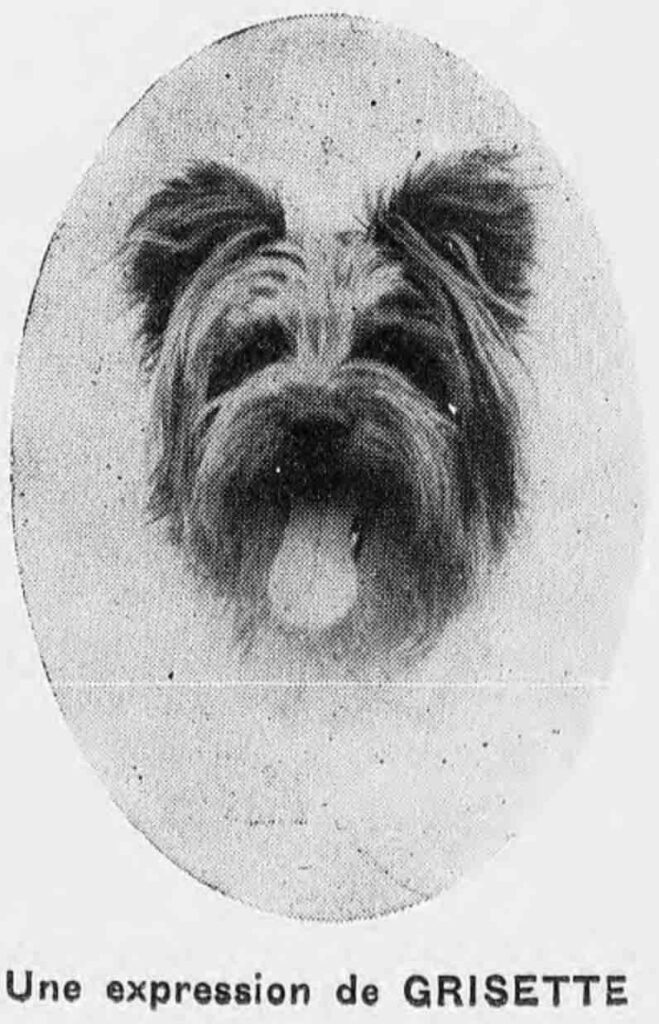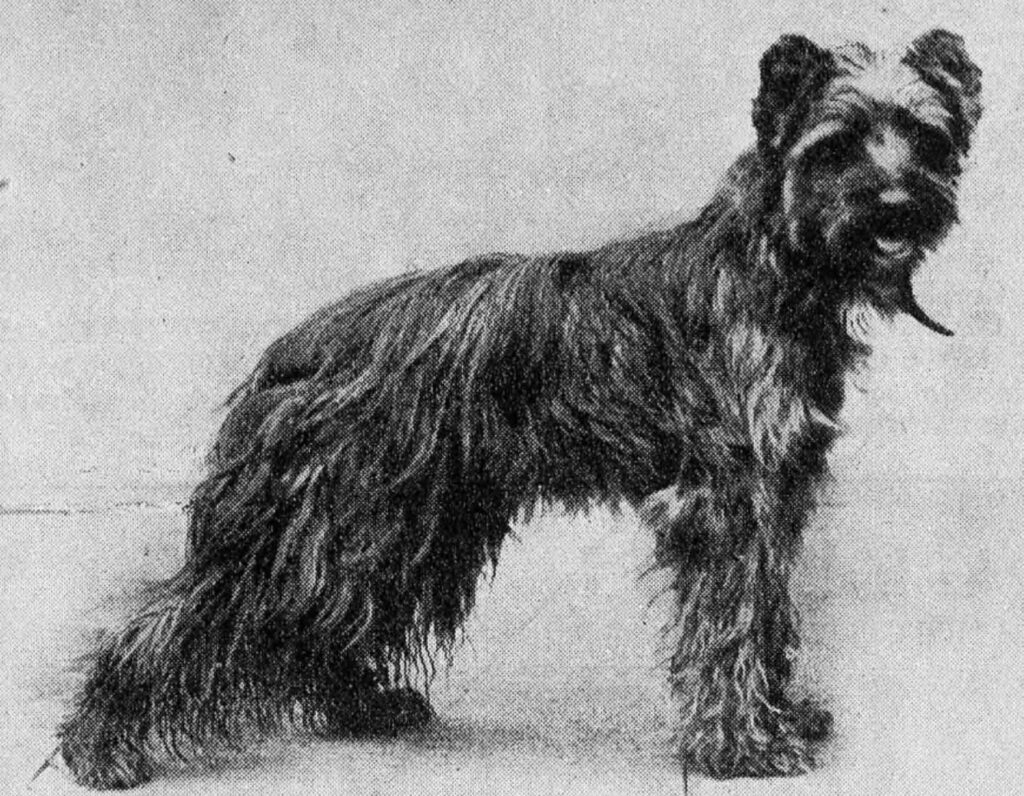I’m grateful to Magdalena Mühlböck for the translation in English!
The 3 types of standard (Arbazie, Bagnères, FaceRase):
There are 3 types in the standard (FaceRase = smooth-face, Arbazie = middle-longhaired, Bagnères = longhaired/rough) but this post is only concerning the types of Arbazie and Bagnères. It’s about comparing THOSE two to each other and to compare them to the “modern” editions of a PyrShep in order to draw the limit of long-haired PyrSheps.
We will notice:
1 The middle long haired type (poil mi-long) is the ideal of the original standard (1923-26). This is the type of Arbazie.
2 The long haired Pyrshep (poil long) is second-class quality. This is the type of Bagnères – „moins distingué“ = less characteristic / less concise than the Arbazie
3 Cadenettes are not wanted BUT the disposition is accepted and even treasured by some but not their expression.
4 It’s an analogy to the Puli and the Tibetan Terrier: Both breeds essentially have the same fur structure, but one breed is required to be brushed and the other isn’t.
5 For the PyrShep it’s to act alike to the Tibetan Terrier: The PyrShep has to be brushed or kempt, just like Mégnin required it in 1928 (concerning Farou de l’Adour) and just like Mansencal described it in 1971.
The standard was worked on in the early 1920’s by „des montagnards, des bergers, des utilisateurs parmi lesquels des zootechniciens notoires – mountaneers, herdsmen, wranglers/users among them notorious connoisseurs of animal breeding“ (Dhers, Chiens, 1956, p. 30-31). The driving force for the final standard was Bernard Sénac-Lagrange (shortened to BSL in the rest of this post). He also portraits himself like that in „L’Éleveur“ (released 26.02.1928) where he quarrels with Jacques Motte, the president of Club Francais du Chien de Berger des Pyrénées, a rivaling Club to RACP. BSL defends not only his own female Berouyette de Lucvielle ( = type of Arbazie) but also Nanouk de Turon ( = type of Bagnères) owned by André Dardignac.
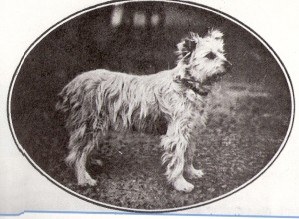
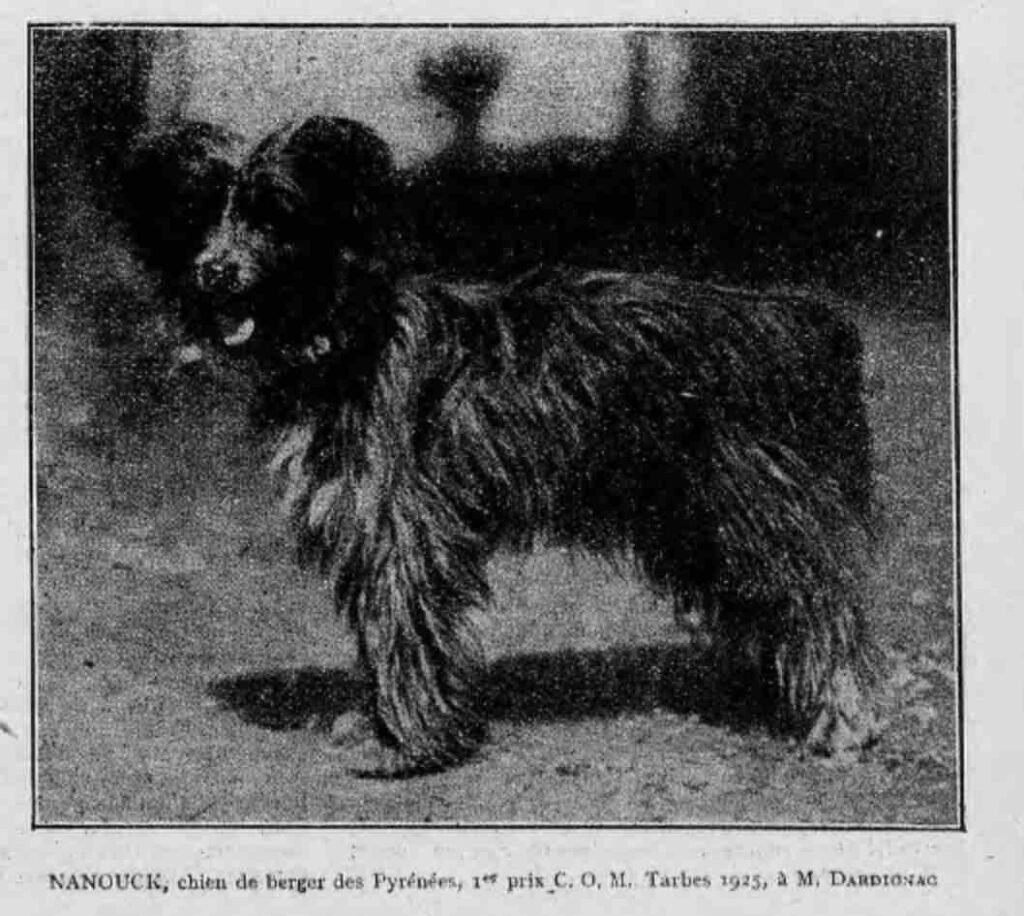
We will discuss dogs with Nanouk’s type in the following paragraphs as they don‘t exactly align with the standard but were still appreciated by specialists like BSL, Dhers and Mégnin.
The authors of the standard faced between 1923 and 1925 the rough task of summing up the different types of PyrSheps that occurred in the valleys. With that they abandon the differences not only between the valleys but also regarding the Face Rase coat type, that is seen these days as the polar opposite of the Poil Long type (I have to admit I did that too for about 20 years). J.Dhers, expert on the pyreneans and long time cynological partner of BSL said the following in 1956:
ces différences ne portent du reste que sur de secondaires points de détail / these differences are of secondary importance: Ce sont: le chien à face rase; les variétés du Labéda aux oreilles plates et au fouet en sabre; l’Arbazie, véritable type du standard, de Bagnères, moins distingué; de Cauterets, réellement typique; de Saint-Béat, au crâne beaucoup plus arrondi; d’Azun, petit chien noir qu’un profane pourrait prendre pour un diminutif de Groenendal.
Beginning with the first drafts 1923 until the finished text 1925/26, the authors of the standard, based the standard for the long haired variety ( that is: versus FaceRase) on the “Type of Arbazie”
… l’Arbazie, véritable type du standard – Arbazie, the type to standard …
The second long haired type, the „type of Bagnères-de-Bigorre“ is also contained in the standard. Dhers said:
… fouet en sabre; l’Arbazie, véritable type du standard, de Bagnères, moins distingué; de Cauterets …
As you can see, the Arbazie type and the Bagnères are only divided by comma while they are divided through a semicolon to the preceding Labéda and the following Cauterets type – that clearly has a meaning in the listing. Nonetheless the Bagnères type is NOT equal to the Arbazie type! Dhers implies that through calling it “moins distingué” which means “less characteristic / less typic”.
But some breeders, even before the standard was written, already committed to the type of Bagnères. For example that would be Dardignac, living in Bagnères and Louis Barret, a photographer in Tarbes but living in Séméac, where he was neighbour to another PyrShep breeder, „de Sémeác“, kennel owned by Dr. Lacassagne, whose Farou de Séméac (…with a tad to short head… see below) was used by Barret as a stud male and even was in co-ownership with Barret. Another dog was also in co-ownership with Barret, the female Troye de Séméac. She stands out with a very interesting fur color „blanc sale – dirty white“ – she was not shown at the show in Tarbes 1924 but she was there as her owner was secretary of the ring.
Not only Lacassagne had dogs in co-ownership. For example Dardignac had some too, which could and can lead to mix-ups: In my book (2000, 1. Band, p. 248) Grisette de Turon was attributed to Dardignac when in reality she was bred by Barret which makes her Grisette des Gaves and not de Turon. Barret didn’t show his dogs often but the dogs of Dardignac are put on the same step as the dogs from the kennel „de Lucvielle“ by BSL — we know about this because J. Dhers, as the sub-editor of the magazine „L’Éleveur“, visited and reviewed multiple shows, just like Toulouse June 05/06 1927:
Une excellente classe de chiens de berger des Pyrénées avec notamment les remarquables sujets de M. Dardignac et les chiennes de M. Sénac-Lagrange: aucune comparaison à établir avec l’ensemble vu à Paris.
Nanouk de Turon is here representing the breeding of Dardignac and Calypso de Lucvielle and Amourette de Lucvielle are the females shown by Sénac-Lagrange.
Louis Barret and André Dardignac both committed to the type of Bagnères-de-Bigorre. Barret starting 1915 (!), where there was no universal standard: Real pyrenees people don’t need a standard! The type of Bagnères-de-Bigorre is described by Barret 1931, after 15 years of selecting PyrSheps as:
„… avec leur toison longue, le type parfait du berger pyrénéen des régions montagneuses… – with their long fur they are the perfect type of the PyrShep in the mountains…”.
avec leur toison LONGUE ! So that is “long fur”, the “long haired type” – which we would not call them that today. Another quote of Barret:
„… une toison abondante … the célèbre étalon „Nanouk de Turon“ considéré à juste titre comme l’un des plus remarquables Bergers des Pyrénées … – voluminous fur … – the well known stud dog Nanouk de Turon is seen as one of the most remarkable PyrSheps”.
une toison ABONDANTE ! Would the fur of Nanouk de Turon be called voluminous today?
In comparison to toison abondante and toison longue nowadays, the PyrSheps of Barret and Dardignac are to be called moderate in regards to their fur length and amount.
Barret and BSL both talk about the importance of the surroundings of dogs in breeding. Barret about his breeding bitches:
„… les lices sont maintenues dans leur véritable milieu, c’est-à-dire au travail des troupeaux – the breeding bitches are held in their true biotopes – meaning they are working the livestock.
But Barret is not only focused on the correct fur structure for working the herd – he’s also focused on maintaining the mentality of the PyrSheps:
Pour conserver tout l’influx nerveux particulièrement dominant dans cette race, les lices du Chenil des Gaves sont maintenues dans leur véritable milieu, c’est-à-dire au travail des troupeaux…
To summarize that: The type of Bagnères-de-Bigorre plays a big role in the eyes of the authors. It’s seen as THE long haired type in contrast to the medium-length haired type of Arbazie. Its fur is described as voluminous and long – where voluminous is definitely not excessive. Comparing the amount of fur in the 1920s with that of these days, we can see that the breed has changed in the past 40 years – but not for the better: The fur has gotten excessivly long and voluminous compared to the 1920’s dogs. Could the dogs that are born now still work in the mountains like the dogs that were bred by Barret? Especially cadenettes are not practical for dogs working animals. Did the “furry” stud dogs of Barret of Dardignac have cadenettes? NO, they didn’t: They show the endowment for cadenettes, but they do not materialise the characteristic trait of cadenettes, even though their fur was described as voluminous or plentiful. The picture documentation of the breed and it’s starting with a dog in the Histoire Naturelle written by the Comte de Buffon et al. (ca. 1749) to the first distinct representation of PyrSheps 1827 ( > https://vom-wunderhorn.de/historische-fotos-dokumente/ ) until 1978 show, if I remember correctly, only two dogs with real cadenettes – and exactly those are what Paul Mégnin (chief editor and cynologist) calls not to type, impractical and not up to standard. To further this point, a comment of Paul Mégnin in Lyon 1928 regarding Farou de l‘Adour who was shown with cadenettes: He likes the texture of the fur and compliments it but says that it‘s unacceptable that his owner didn‘t brush the fur „je ne dis pas toiletté mais débarrassé de ses „matelottes“, il a un poil d’une consistance idéale, il ne faut pas par un manque de toilette laisser ce poil devenir ce qu’il ne doit pas être!“, is what he said.
1971, Mansencal had expressed the same opinion in a small contribution in „La Vie Canine“.

Mansencal’s statement 1971 is contrary to the cadenettes shown by Isba in 1978 and since then, shown by every corded BdP: N’OUBLIANT AUCUNE MÈCHE / keine Strähne / Zotte vergessend / not losing sight of a single villus!
It‘s obvious that the Bagnères type is prone to cording, so that‘s not a scandal: The scandal is since 1978, that the predisposition is allowed to form the end product namely the cords. Leading cynologists of the „founding times“ would see them as not up to standard. That is why the „cadenette-craze“ should not be allowed and is positioned opposite of the original standard. If we want to breed original PyrSheps again, we need to stop the cadenettes-craze as soon as possible and to return to the type of Arbazie.
It’s about time that PyrShep breeders recognize the following: Cadenettes are the worst what could happen to the breed. We have to go back to the true type of the PyrShep, that’s primarily the Arbazie type followed by the Bagnères type. Continuing the wrong track would be treason to the ideal that the 1920’s authors had in mind when writing the standard. Let us bear in mind that they were looking at dogs like Nanouk de Turon owned by André Dardignac and Grisette des Gaves owned by Louis Barret for the Bagnères type and principally at dogs like Berouyette de Lucvielle owned by Bernard Sénac-Lagrange and Fine Mouche de la Bonne-Brise owned by Pierre Poey in Pau.
